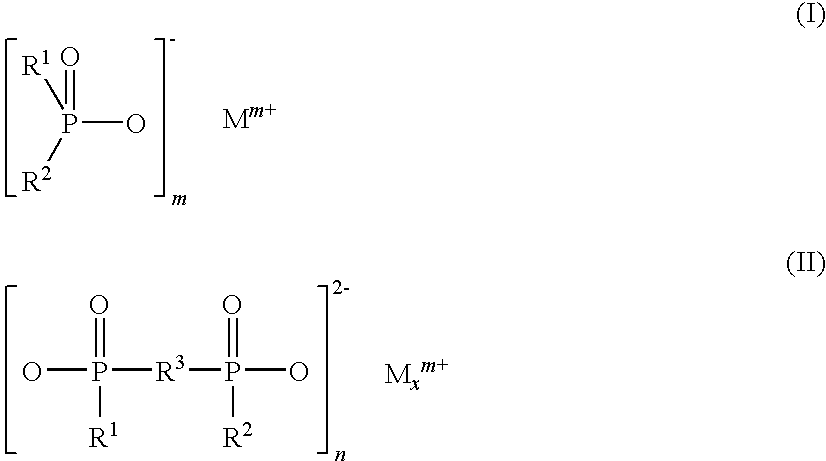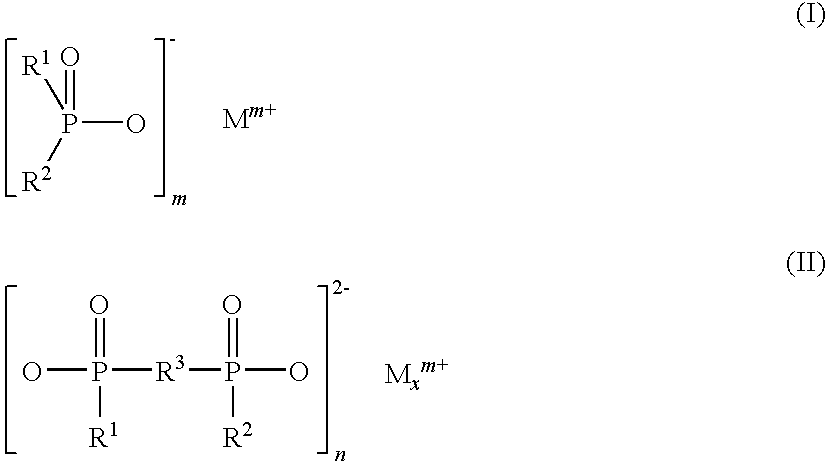Resin Composition Excellent in Flame Retardance
a technology of composition and flame retardancy, applied in the field of resin composition, can solve the problems of increased dimensional change during water absorption, defective appearance of molded pieces, and insufficient flowability, and achieve the effects of reducing the generation of deposits, and reducing the generation of gas
- Summary
- Abstract
- Description
- Claims
- Application Information
AI Technical Summary
Benefits of technology
Problems solved by technology
Method used
Image
Examples
examples
[0177]The present invention will now be described in further detail by way of Examples and Comparative Examples. However, the invention is not intended to be limited to these Examples.
[0178]Note that the raw materials and measurement methods used in Examples and Comparative Examples are described below.
Raw Materials
[0179](A) Polyamide
[0180](A-1) Polyamide 9T (Hereinafter Abbreviated as PA9T-a)
[0181]With reference to the method described in the Examples of JP-A-2000-204239, 3,256.2 g (19.6 mol) of terephthalic acid, 2,690.9 g (17.0 mol) of 1,9-nonanediamine, 474.9 g (3.0 mol) of 2-methyl-1,8-octanediamine, 97.7 g (0.8 mol) of benzoic acid, 6.5 g (0.1% by weight based on the total of the preceding four polyamide raw materials) of sodium hypophosphite monohydrate, and 6 litters of distilled water were placed in an autoclave having an inner volume of 20 litters, whose inside was then purged with nitrogen. The autoclave was stirred at 100° C. for 30 minutes, followed by raising the inter...
examples 1 to 13 and 16 to 18
and Comparative Examples 2 to 4
[0257]A twin screw extruder having one supply port on the upstream side and two supply ports on the downstream side (one port at the position of 0.4 and one port at the position of 0.8 when the overall length of the extruder cylinder was set to 1.0) (ZSK-26MC manufactured by Coperion Holding GmbH (Germany)) was provided. The cylinder temperature was set to 320° C. from the supply port on the upstream side (hereinafter referred to as the upstream supply port) to the supply port at the position of L=0.4 (hereinafter referred to as the central supply port) and, downstream to the central supply port, 310° C. when polyamide 9T was used and 280° C. when polyamide 66 was used.
[0258]According to the compositions described in Tables 1 to 4, raw materials for each thereof were supplied and melt-kneaded to provide pellets. To control the moisture content of the pellets, after extrusion, the pellets were dried in a dehumidification drier set at 80° C. and then pla...
example 14
[0264]According to the composition described in Table 3, raw materials therefor were melt-kneaded under the same conditions as in Example 1 to provide pellets. The resultant pellet was attempted to be molded, but a molding tool could not completely be filled with the resin under the condition of a cylinder temperature of 320° C. Accordingly, when the pellets was again attempted to be molded by raising the cylinder temperature to 330° C., the filling was completed. This obtained molded piece was subjected to the above evaluations.
PUM
| Property | Measurement | Unit |
|---|---|---|
| Fraction | aaaaa | aaaaa |
| Percent by mass | aaaaa | aaaaa |
| Percent by mass | aaaaa | aaaaa |
Abstract
Description
Claims
Application Information
 Login to View More
Login to View More - R&D
- Intellectual Property
- Life Sciences
- Materials
- Tech Scout
- Unparalleled Data Quality
- Higher Quality Content
- 60% Fewer Hallucinations
Browse by: Latest US Patents, China's latest patents, Technical Efficacy Thesaurus, Application Domain, Technology Topic, Popular Technical Reports.
© 2025 PatSnap. All rights reserved.Legal|Privacy policy|Modern Slavery Act Transparency Statement|Sitemap|About US| Contact US: help@patsnap.com



